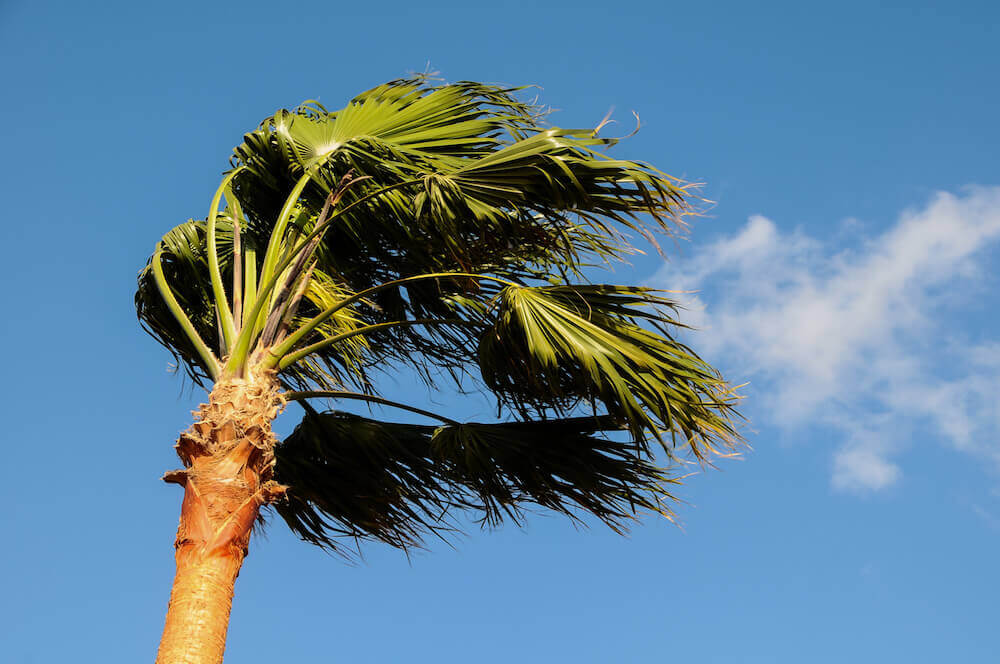
Caring for Your Florida-Friendly Palm Trees after a Storm
If you’ve been a Florida resident for a decent amount of time, you know that this state is no stranger to various degrees of storm, from a docile rain shower to the roughest hurricanes. As a result of this, many plant species have adapted to heavy winds. That doesn’t mean that the trees on your Florida lawn are completely immune to wind damage.
Once it’s safe to survey your landscape after a bad storm, there are plenty of steps that can be taken to properly manage your palm trees.
The Basics of Palm Tree Growth
If you are going to understand how to care for a palm tree and restore it after it has been damaged, you must first learn the way in which a palm tree grows. The growing point of a palm is called the apical meristem, but it is also called the palm bud or heart of the palm.
The palm bud is located at the top of the trunk and this is where all new leaves come from, surrounding the bud. If, due to wind damage or a storm of any sort, the bud is damaged, new leaves won’t have the chance to develop, and this is how a palm is in danger of dying.
Try as you might, you won’t be able to predict which palms will survive such damage, unless the trunk of the palm itself is broken, or you can tell that the bud has been damaged. Depending on the species of palm tree you have, they will shed a certain amount of leaves.
Here are the basic reminders for post-storm palm care:
- Above all else, understand that it will take at least six months, if not longer, before you start noticing any signs of recovery in your palm tree.
- Signs of recovery include new leaves emerging.
- If the new leaves don’t look healthy, that’s okay—they may appear abnormal, but as more and more leaves grow from the bud, they will begin to regain their normal coloration, size, and figure.
- Palm trees that have been damaged from a storm must be monitored carefully during the next several years.
- After a storm hits an area, people living there often examine their landscape with a fine-toothed comb, which isn’t the case under usual conditions. They may not have realized that their trees expressed signs of damage before the storm even started.
- With this in mind, make it a priority to determine which problems existed before the storm, and which problems developed because of the storm.
How to Interact with Palm Trees Directly After a Storm
In terms of physically interacting with the palm, the first thing that should be done if it is broken is to cut the stem at the base and remove it. If you’re working with a single-stemmed palm, know that with this amount of damage, it will not recover. If you’re working with a clustering palm, new stems will emerge with time, and in most cases, the palm will survive.
With a severely damaged single-stemmed palm, you should remove or grind the stumps, because they are susceptible to Ganoderma zonatum conk (which is a type of mushroom). These conks, if noticed, must be removed and disposed of with garbage that will be incinerated or buried. While the fungus is not harmful to people or animals, it could easily kill other palms if it has the chance to spread further.
Stand your surviving palms upright as soon as you can go outside after the storm. Make sure that they are replanted at the same depth they were planted at before. If, after surveying your lawn, you see broken leaves that are still green, you should keep them attached, because they will still function when it comes to photosynthesis.
Products to Apply to Palm Trees Post-Storm
Your fertilizer program should be implemented without change for palm trees that have not been uprooted. If you had to replant, don’t add extra fertilizer until you see noticeable growth, which may take a month or longer.
Currently, there is no research to document the benefits of using fungicides after a hurricane.
If you’ve enjoyed your Florida-Friendly lawn for long enough, you understand that after a storm, some major damage can be done to the palm trees that accompany your turf grass, shrubs, and other foliage. Taking care of them the right way in order to revitalize them will allow you to get your gorgeous lawn back to normal in no time!